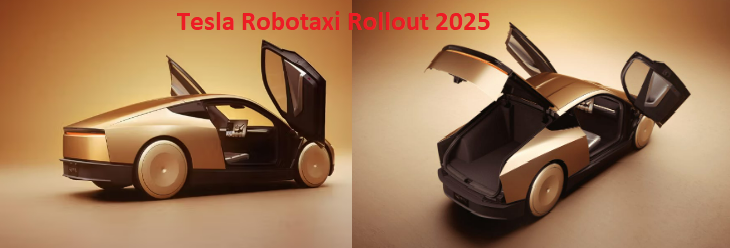Tesla Robotaxi Rollout 2025 Launch: A Bold Leap in 2025
The upcoming Tesla Robotaxi Rollout 2025 represents a major leap in autonomous driving technology. With no human driver, no steering wheel, and a full AI-powered brain, this vehicle is built to change how we think about urban mobility. The promise is simple: order a car from your phone, and it shows up—driven by artificial intelligence. However, as much as this innovation sounds like a sci-fi dream come true, it comes bundled with complex real-world issues.
Tesla’s mission is to create a driverless ride-hailing system that is efficient, eco-friendly, and affordable. But will these robot cars actually deliver what’s promised—or will they raise more questions than they answer?
Tesla’s push toward a fully autonomous ride-sharing fleet has ignited excitement and skepticism alike. Is this the future of mobility or a tech dream racing ahead of its reality?
Tesla Robotaxi Key Specifications
Here are the key performance specs of the Tesla Robotaxi Rollout 2025:
- Model Platform: Built on modified Model 3 architecture
- Autonomous System: Full Self-Driving (FSD) v12.4 with Tesla Vision
- Speed Cap: 75 mph
- Range: Approximately 300 miles per charge
- Charging: Supercharger V4 compatibility
- Connectivity: 5G & Starlink backup
- Passenger Capacity: 4 seats, no steering wheel or pedals
Top Features of the Tesla Robotaxi
The Tesla Robotaxi Rollout 2025offers innovative features aimed at transforming ridesharing:
- Hands-Free Experience – Fully autonomous operation with no steering wheel or manual controls.
- Mobile App Integration – Riders can unlock doors, start rides, and adjust settings via Tesla’s app.
- Smart Cabin – Includes voice control, touchscreen for infotainment, and biometric safety measures.
- AI Surveillance – Cameras monitor interior activity for passenger safety.
Challenges Tesla Robotaxi Faces Today
Despite its futuristic vision, the Tesla Robotaxi faces some pressing issues:
- Navigation Errors: Misreading street signs and unpredictable stops in high-traffic zones
- Software Glitches: FSD inconsistencies during turns and merges
- Public Skepticism: Safety concerns, especially for seniors and parents traveling with kids
- Regulatory Pushback: Some cities have delayed approval pending more robust safety data
Connectivity, AI & Eco-Friendly Goals
Tesla Robotaxi supports Dojo-powered AI learning, collecting millions of data points per trip. This helps improve decision-making across the fleet. Its zero-emission EV design also fits Tesla’s broader sustainability goals, replacing gas-powered taxis with clean, electric alternatives.
Public Response to the Tesla Robotaxi
Reviews of the Tesla Robotaxi have been mixed. Tech enthusiasts admire the bold design and efficiency, while average riders express hesitation about safety and consistency.
Market Impact in the U.S.
Tesla’s rollout will reshape the ride-sharing industry. Companies like Uber and Lyft are watching closely, and legacy automakers such as GM and Ford are investing in rival autonomous fleets. Urban areas with supportive regulations like California, Texas, and Arizona will be early testing grounds.
Conclusion: What’s Next for Tesla Robotaxi?
The Tesla Robotaxi is a visionary product that could eventually disrupt the rideshare industry. However, it currently stands at a crossroads between innovation and practicality. Until Tesla resolves software bugs, enhances rider trust, and secures full legal approval, the dream of autonomous cities will remain just beyond reach.
Still, it’s clear the future of transport is shifting—and Tesla is leading that charge.
FAQs
Q1. What is the Tesla Robotaxi?
The Tesla Robotaxi is a fully autonomous electric vehicle designed for self-driving ridesharing without a human driver.
Q2. When can I ride a Tesla Robotaxi?
Limited beta access is available in certain U.S. cities, with wider availability expected by late 2025.
Q3. How does Tesla Robotaxi ensure safety?
It uses Tesla Vision, Dojo AI, and cabin surveillance for real-time risk mitigation—though full safety is still under evaluation.
Q4. Will it replace Uber or Lyft?
Potentially, yes. Tesla’s model aims to undercut traditional ride-sharing services with lower costs and higher efficiency.

